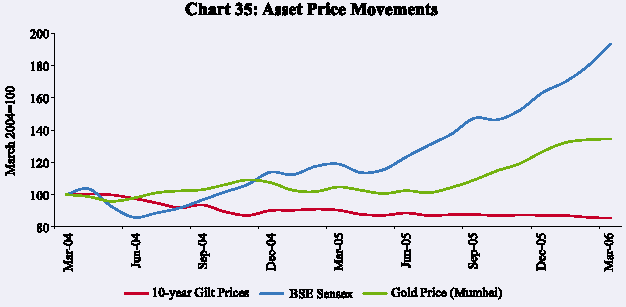IV. Price Situation - RBI - Reserve Bank of India
IV. Price Situation
Headline inflation firmed up in a number of economies during 2005-06 on account of international crude oil prices reaching a record high and remaining at elevated levels. Accordingly, many central banks tightened monetary policy during 2005-06 in order to contain inflation and inflationary expectations, especially in view of the fact that a significant part of the increase in international crude oil prices is increasingly viewed as somewhat permanent. Nonetheless, compared to the previous oil shocks, the impact of higher oil prices on economic activity and inflation expectations seems to have been largely contained reflecting a variety of factors such as increased competition due to globalisation, fall in intensity of oil usage in advanced economies, continuous pre-emptive monetary tightening through measured increases in policy rates and, in case of many emerging market economies, less-than-complete pass-through.
In India, headline inflation and inflation expectations remained well-contained during 2005-06, despite continued dominance of supply-side factors. Fiscal and monetary measures undertaken since mid-2004 to reduce the impact of imported price pressures on domestic inflation and to stabilise inflationary expectations were successful in containing inflation towards the desired trajectory during 2005-06.
Global Inflation
Headline inflation firmed up in the second half of 2005 in a number of economies in tandem with the movements in international crude oil prices. With oil prices reaching a record high of US $ 70.8 a barrel in August 2005, headline inflation edged up sharply in major advanced economies in September 2005 reaching 4.7 per cent in the US, 2.6 per cent in the Euro area and 2.5 per cent in the UK. In the subsequent months, headline inflation edged somewhat lower as oil prices retreated from their record high level. Nonetheless, inflation still remains at elevated levels. With oil prices remaining high and volatile, major central banks have, therefore, resorted to pre-emptive monetary tightening in order to contain inflationary expectations. Reflecting the strong economic activity and the incipient inflationary pressures, the US Federal Reserve persevered with its measured pace of monetary tightening raising its target Federal Funds rate to 4.75 per cent – an increase of 375 basis points since the tightening began in June 2004 (25 basis points hike at each of its 15 meetings) (Table 28 and Chart 27). According to the US Federal Open Market Committee (FOMC), although possible increases in resource utilisation and elevated prices of energy and other commodities have the potential to add to inflation pressures, inflation expectations in the US remain contained. The FOMC believes that some further policy firming may be needed to keep the risks to the attainment
| Table 28: Inflation Indicators - Developed Economies |
||||||||
| (Per cent) |
||||||||
| Country/ |
Key Policy Rate |
Policy Rates |
Changes in Policy |
|||||
| Inflation |
Growth (y-o-y) |
|||||||
| Region |
(Latest) |
Rates (bp) |
||||||
| (since end- |
2005 |
2006 |
2004 |
2005 |
||||
| March 2005) |
(February) |
(February) |
(Q4) |
(Q4) |
||||
| 1 |
2 |
3 |
4 |
5 |
6 |
7 |
8 |
|
| Australia |
Cash Rate |
5.50 |
0 |
2.6 * |
2.8 * |
1.5 |
2.7 |
|
| Canada |
Overnight Rate |
3.75 |
125 |
2.1 |
2.2 |
3.3 |
2.9 |
|
| Euro area |
Interest Rate on Main |
|||||||
| Refinancing Operations |
2.50 |
50 |
2.1 # |
2.2 # |
1.6 |
1.6 |
||
| Japan |
Uncollateralised Overnight |
|||||||
| Call Rate |
0 |
** |
-0.3 |
0.5 |
0.5 |
4.3 |
||
| UK |
Repo Rate |
4.50 |
(-)25 |
1.7 |
2.0 |
2.7 |
1.8 |
|
| US |
Federal Funds Rate |
4.75 |
200 |
3.0 |
3.6 |
3.8 |
3.2 |
|
| y-o-y : year-on-year. * : Q4. # : March. |
||||||||
of both sustainable growth and price stability roughly in balance. Similarly, recognising upside risks due to the potential second-round effects in wage and price setting behaviour from oil market developments and further increases in administered prices and indirect taxes, the European Central Bank (ECB), after maintaining rates at historically low levels for two and a half years, raised the key policy rate by 50 basis points during 2005-06 – 25 basis points each in December 2005 and March 2006 – to keep medium to long-term inflation expectations in the Euro area anchored to levels consistent with price stability. In the UK, on the other hand, the Bank of England cut the policy repo rate by 25 basis points on August 4, 2005 in response to the weakening of economic activity.
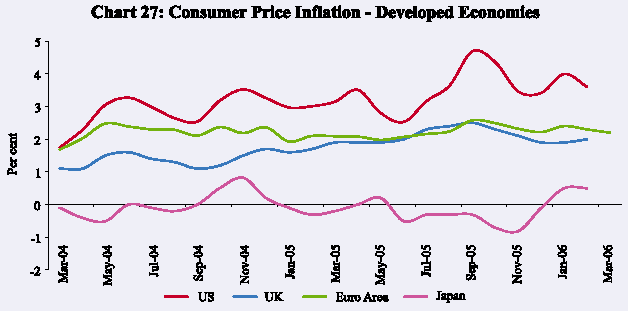
In Japan, year-on-year consumer price inflation turned positive in January 2006. With output gap gradually narrowing and firms and households shifting up their expectations for inflation, the Bank of Japan (BoJ) expects year-on-year changes in the consumer price index to remain positive. The BoJ, therefore, decided on March 9, 2006 to change the operating target of money market operations from the outstanding balance of current accounts at the Bank to the uncollateralised overnight call rate. With inflation continuing to remain low, the BoJ indicated that it will encourage the uncollateralised overnight call rate to remain at effectively zero per cent.
Amongst major Asian economies, inflation in Indonesia increased sharply from 9.1 per cent at end-September 2005 to 18.4 per cent in November 2005 before moderating to 15.7 per cent in March 2006; in Thailand, inflation edged higher from less than three per cent in early 2005 to 6.2 per cent by October 2005 before easing marginally to 5.7 per cent in March 2006. With inflation expected to remain high, these central banks continued to tighten their monetary policies. The Bank Indonesia has raised the policy rate by 425 basis points since July 2005 – 25 basis points in August 2005, 125 basis points in September 2005, 100 basis points in October 2005, 125 basis points in November 2005 and 50 basis points in December 2005 – to 12.75 cent. The Bank of Thailand has raised policy interest rates by 250 basis points from June 2005 to 4.75 per cent. With inflation above the target, the Bank of Philippines raised the policy reverse repo rate by 75 basis points to 7.5 per cent – 25 basis points each in April 2005, September 2005 and October 2005. In Korea, even though inflation remains modest, latent inflationary pressures are seen due to economic recovery and high oil prices. The Bank of Korea has accordingly raised the policy rate by 75 basis points since end-September 2005 to 4.00 per cent – 25 basis points each in October 2005, December 2005 and February 2006 (Table 29 and Chart 28). On
| Table 29: Inflation Indicators - Emerging Market Economies |
||||||||
| (Per cent) |
||||||||
| Country/ |
Key Policy Rate |
Policy Rates |
Changes in Policy |
|||||
| Inflation |
Growth (y-o-y) |
|||||||
| Region |
(Latest) |
Rates (bp) |
||||||
| (since end- |
2005 |
2006 |
2004 |
2005 |
||||
| March 2005) |
(March) |
(March) |
(Q4) |
(Q4) |
||||
| 1 |
2 |
3 |
4 |
5 |
6 |
7 |
8 |
|
| Brazil |
Selic Rate |
16.50 |
(-) 275 |
7.5 |
5.3 |
4.9 |
1.4 |
|
| China |
M2 |
3.9 @ |
0.9 @ |
9.5 |
9.9 |
|||
| India |
Reverse Repo Rate |
5.50 |
75 |
4.2 @ |
5.0 @ |
7.0 |
7.6 |
|
| Indonesia |
BI Rate |
12.75 |
4.25 * |
8.7 |
15.7 |
6.7 |
4.9 |
|
| Israel |
Key Policy Rate |
5.00 |
150 |
0.8 @ |
3.1 @ |
4.8 |
4.8 |
|
| Korea |
Overnight Call Rate |
4.00 |
75 |
3.1 |
2.0 |
3.3 |
5.3 |
|
| Philippines |
Reverse Repo Rate |
7.50 |
75 |
8.5 |
7.6 |
5.4 |
6.1 |
|
| South Africa |
Repo Rate |
7.00 |
(-) 50 |
2.6 @ |
3.9 @ |
4.7 |
4.5 |
|
| Thailand |
14-day Repo Rate |
4.75 |
250 |
3.2 |
5.7 |
5.1 |
4.7 |
|
| * : Change since July 2005. @ : February. |
||||||||
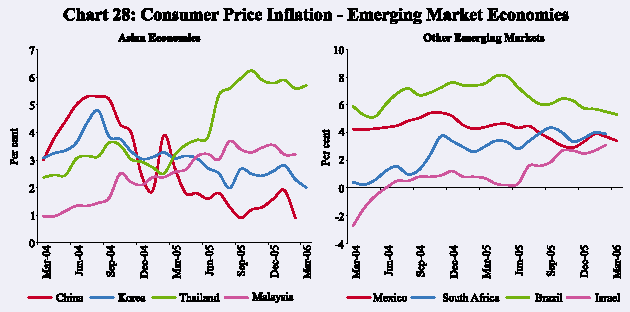
the other hand, consumer price inflation in China decelerated to 0.9 per cent in February 2006 from 3.9 per cent a year ago, mainly due to incomplete pass-through of higher oil prices and declines in the prices of poultry products, clothing, and transport and communications.
Global Commodity Prices
Sharp increase in international crude oil prices to record highs were witnessed during 2005-06 (Chart 29). Non-fuel commodities also increased led by metals and sugar while oilseeds, edibles oils and cotton prices recorded a decline during 2005-06.
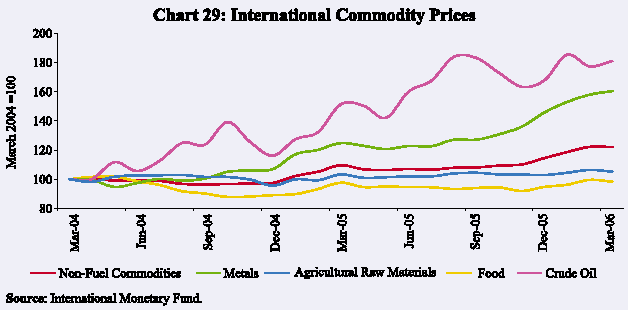
Strong growth in global demand, economic resilience to higher energy costs, hurricane-related supply disruptions in the US (hurricanes Katrina and Rita during August-September 2005) and a three decade low global oil spare capacity pushed up oil prices during 2005-06, despite periodic increases in supply by the Organisation of the Petroleum Exporting Countries (OPEC). Besides, concerns over stability of supplies from the Middle East due to geo-political uncertainties as well as speculative purchases by hedge funds further added to nervousness in the world oil market, imparting a great deal of volatility to oil prices. Reflecting these factors, international crude oil prices reached successive record highs during 2005 – the US West Texas Intermediate (WTI) crude prices rose to an all-time peak of US $ 70.8 a barrel on August 30, 2005 in the immediate aftermath of Hurricane Katrina. Prices in the subsequent months have remained high and volatile. Crude oil prices initially moderated to below US $ 60 a barrel during November-December 2005 due to (i) concerted efforts by the International Energy Agency (IEA) to release emergency stocks of 2 million barrels a day (mb/d) of crude and products to compensate for the outage in the US Gulf Coast due to Hurricane Katrina; (ii) OPEC’s decision to make available existing spare capacity in member countries of around 2 mb/d for a three-month period in its Vienna meeting during September 19-20, 2005; (iii) signs of slowing global oil demand growth; (iv) significant recovery from hurricane damages to oil production in the Gulf of Mexico; and (v) relatively warmer weather during October-November 2005. Prices, however, again edged up to US $ 67-68 a barrel in January 2006 on disruption of Russian natural gas deliveries to Ukraine threatening supplies to Western Europe, unrest in Nigeria and tensions over Iran’s nuclear programme. On the whole, international crude oil prices have surged by about 81 per cent from US $ 33.7 per barrel in March 2004 to US $ 60.9 per barrel in March 2006 (Table 30). After some moderation during February 2006, international crude oil
| Table 30: International Crude Oil Prices |
|||||
| (US dollars per barrel) |
|||||
| Year/Month |
Dubai Crude |
UK Brent |
US WTI |
Average Crude Price |
Indian Basket Price |
| 1 |
2 |
3 |
4 |
5 |
6 |
| 2001-02 |
21.8 |
23.2 |
24.1 |
23.0 |
22.4 |
| 2002-03 |
25.9 |
27.6 |
29.2 |
27.6 |
26.6 |
| 2003-04 |
26.9 |
29.0 |
31.4 |
29.1 |
27.8 |
| 2004-05 |
36.4 |
42.2 |
45.0 |
41.3 |
38.9 |
| 2005-06 |
53.4 |
58.0 |
59.9 |
57.1 |
55.4 |
| March 2004 |
30.5 |
33.8 |
36.7 |
33.7 |
31.9 |
| March 2005 |
45.6 |
53.1 |
54.2 |
50.9 |
48.8 |
| June 2005 |
51.0 |
54.3 |
56.4 |
53.9 |
52.4 |
| September 2005 |
56.5 |
63.0 |
65.5 |
61.7 |
59.3 |
| December 2005 |
53.1 |
56.8 |
59.4 |
56.5 |
54.7 |
| January 2006 |
58.3 |
63.6 |
65.5 |
62.5 |
60.6 |
| February 2006 |
57.6 |
59.9 |
61.6 |
59.7 |
58.6 |
| March 2006 |
57.7 |
62.3 |
62.9 |
60.9 |
59.6 |
| Source : International Monetary Fund and the World Bank. |
|||||
prices again edged up sharply in the first half of April 2006 on concerns over Iran’s nuclear programme and continuing supply disruptions in Nigeria. WTI prices again crossed US $ 69 a barrel on April 11, 2006.
With limited spare global crude oil production capacity and the U.S. oil production and refining industries still to recover fully, oil prices are expected to remain firm in the near future (Table 31). The Energy Information Administration (EIA) of the US, for instance, expects WTI prices to average US $ 65 per barrel in 2006.
Non-fuel commodity prices were led by higher metal prices which reached record/multi-year highs. Metal prices firmed up further during 2005 and the uptrend gathered pace during the first quarter of 2006 on the back of robust construction and manufacturing demand from China and the US. The rally in metal prices has been led by copper, zinc and aluminium (Table 32). With inventories falling to historical lows, copper prices in the first quarter of 2006 (January-March) were 51 per cent higher than that during the corresponding period of 2005. Similarly, zinc and aluminium prices in the first quarter of 2006 were higher by 71 per cent and 28 per cent, respectively, than their levels a year ago. Steel prices stabilised in the second half of 2005 on the back of supply management efforts by major steel producers in the face of strong increase in Chinese production, higher inventories in the US and sluggish demand in Japan. Prices have, however, again edged higher in recent weeks.
As regards food articles, wheat prices firmed up from the second half of 2005. According to the Food and Agriculture Organisation (FAO), wheat prices are expected to moderate in view of good harvest for the 2005 crop and favourable prospects for the newly-sown 2006 crop. Rice prices which increased in 2005 are expected to moderate in the coming months on the back of a record 2005 paddy
| Table 31: World Supply-Demand Balance of Oil |
|||||||||
| (Million barrels per day) |
|||||||||
| Item |
2003 |
2004 |
2005 |
2006 (P) |
2006 P |
||||
| Q1 |
Q2 |
Q3 |
Q4 |
||||||
| 1 |
2 |
3 |
4 |
5 |
6 |
7 |
8 |
9 |
|
| Demand |
|||||||||
| 1. |
OECD |
48.7 |
49.5 |
49.6 |
50.1 |
50.1 |
49.0 |
50.0 |
51.0 |
| 2. |
Non-OECD |
31.2 |
33.0 |
34.1 |
35.1 |
34.6 |
34.6 |
34.9 |
36.3 |
| of which: China |
5.6 |
6.5 |
6.9 |
7.4 |
7.2 |
7.4 |
7.4 |
7.7 |
|
| 3. |
Total (1+2) |
79.9 |
82.5 |
83.6 |
85.2 |
84.7 |
83.6 |
84.9 |
87.3 |
| Supply |
|||||||||
| 4. |
Non-OPEC |
48.9 |
50.1 |
50.2 |
51.0 |
50.6 |
50.5 |
51.1 |
51.8 |
| 5. |
OPEC |
30.7 |
32.9 |
33.9 |
34.3 |
33.8 |
34.1 |
34.6 |
34.5 |
| 6. |
Total (4+5) |
79.6 |
83.1 |
84.1 |
85.3 |
84.4 |
84.6 |
85.7 |
86.3 |
| Stock Changes |
0.3 |
-0.6 |
-0.5 |
-0.1 |
0.3 |
-1.0 |
-0.8 |
1.0 |
|
| P : Projections. |
|||||||||
| Table 32: International Commodity Prices |
|||||||||
| 2005 |
2006 |
||||||||
| Commodity |
Unit |
2004 |
2005 |
Jan-Mar |
Apr-Jun |
Jul-Sep |
Oct-Dec |
Jan-Mar |
Mar |
| 1 |
2 |
3 |
4 |
5 |
6 |
7 |
8 |
9 |
10 |
| Energy |
|||||||||
| Coal |
$/mt |
53.0 |
47.6 |
51.3 |
51.2 |
48.4 |
39.6 |
46.9 |
49.8 |
| Crude oil (Average) |
$/bbl |
37.7 |
53.4 |
46.2 |
50.8 |
60.0 |
56.6 |
61.0 |
60.9 |
| Non-Energy Commodities |
|||||||||
| Palm oil |
$/mt |
471.3 |
422.1 |
413.3 |
421.7 |
415.0 |
438.3 |
436.4 |
440.0 |
| Soybean oil |
$/mt |
616.0 |
544.9 |
521.3 |
548.0 |
551.7 |
558.7 |
535.3 |
539.0 |
| Soybeans |
$/mt |
306.5 |
274.7 |
270.8 |
290.7 |
278.3 |
258.9 |
256.7 |
256.0 |
| Rice |
$/mt |
237.7 |
286.3 |
289.9 |
292.0 |
281.6 |
281.6 |
298.8 |
303.5 |
| Wheat |
$/mt |
156.9 |
152.4 |
151.9 |
142.0 |
151.0 |
164.5 |
173.8 |
174.4 |
| Sugar |
c/kg |
15.8 |
21.8 |
19.6 |
19.3 |
22.0 |
26.3 |
37.5 |
38.1 |
| Cotton A Index |
c/kg |
136.6 |
121.7 |
117.6 |
122.6 |
120.4 |
126.1 |
131.1 |
129.3 |
| DAP |
$/mt |
221.2 |
247.0 |
226.4 |
235.6 |
261.6 |
264.5 |
259.6 |
256.6 |
| Urea |
$/mt |
175.3 |
219.0 |
198.1 |
241.6 |
211.7 |
224.7 |
219.2 |
244.1 |
| Aluminium |
$/mt |
1715.5 |
1898.3 |
1899.0 |
1789.8 |
1828.8 |
2075.6 |
2420.8 |
2429.1 |
| Copper |
$/mt |
2865.9 |
3678.9 |
3267.7 |
3389.2 |
3756.6 |
4302.0 |
4940.0 |
5102.8 |
| Gold |
$/toz |
409.2 |
444.8 |
427.1 |
427.3 |
439.5 |
485.6 |
554.0 |
557.1 |
| Silver |
c/toz |
669.0 |
733.8 |
699.9 |
718.2 |
708.8 |
808.3 |
969.4 |
1037.5 |
| Steel products index |
1990=100 |
121.5 |
137.9 |
132.7 |
141.6 |
138.6 |
138.6 |
138.6 |
138.6 |
| Steel cold rolled coilsheet |
$/mt |
607.1 |
733.3 |
683.3 |
750.0 |
750.0 |
750.0 |
750.0 |
750.0 |
| Steel hot rolled coilsheet |
$/mt |
502.5 |
633.3 |
583.3 |
650.0 |
650.0 |
650.0 |
650.0 |
650.0 |
| Tin |
c/kg |
851.3 |
738.0 |
807.7 |
796.3 |
704.7 |
643.2 |
760.6 |
794.0 |
| Zinc |
c/kg |
104.8 |
138.1 |
131.5 |
127.3 |
129.7 |
164.0 |
224.2 |
241.7 |
| $ : US dollar. c : US cent. bbl : barrel. mt : metric tonne. kg : Kilogram. toz : troy oz. |
|||||||||
output. Prices of oilseeds, which edged up during March-June 2005 due to sudden deterioration of production prospects in South America, have eased since August 2005 with the waning of weather concerns and record carryover stocks at the close of the marketing season (October-September). On the other hand, notwithstanding some easing during the second half of 2005, prices of edible oils and fats are expected to strengthen due to strong consumption demand from China and India and demand for non-food uses such as biodiesel from the EU and the US.
After remaining broadly stable during April-June 2005, sugar prices have firmed up sharply since September 2005. Prices during the first quarter of 2006 were 91 per cent higher than that during the corresponding period of 2005, reflecting declining global inventories. Although global production in the 2005-06 season (October-September) is expected to increase led by higher production in Brazil and India, higher global sugar consumption, especially from the developing countries of the Far East and Latin America and declining stocks are likely to keep sugar prices firm in the coming months. Global cotton prices, which had declined till August 2005 reflecting a rebound in production, have increased since October 2005 on the back of strong demand. According to the International Cotton Advisory Committee (ICAC), global demand is estimated to increase by about four per cent during 2005-06 and this is expected to keep prices firm.
Inflation Conditions in India
Headline inflation, based on movement in the wholesale price index (WPI), was 4.0 per cent as at end-March 2006 as compared with 5.1 per cent a year ago (Table 33). Inflation initially increased during 2005-06 to an intra-year high of 6.0 per cent on April 23, 2005 reflecting increases in prices of fruits and vegetables, iron and steel and select petroleum products such as furnace oil and naphtha. Subsequently, with the base effect coming into play and the revival of the monsoon, inflation began to ease reaching an intra-year low of 3.3 per cent on August 27, 2005. Inflation again edged up during the third quarter of 2005-06 - but remaining
| Table 33: Wholesale Price Inflation in India (year-on-year) |
|||||||
| (Per cent) |
|||||||
| Commodity |
2004-05 (March 26) |
2005-06 (March 25) |
|||||
| Weight |
Inflation |
WC |
Inflation |
WC |
|||
| 1 |
2 |
3 |
4 |
5 |
6 |
||
| All Commodities |
100.0 |
5.1 |
100.0 |
4.0 |
100.0 |
||
| 1. |
Primary Articles |
22.0 |
1.3 |
5.5 |
5.3 |
28.5 |
|
| Food Articles |
15.4 |
3.0 |
8.9 |
6.3 |
23.8 |
||
| i. Rice |
2.4 |
2.9 |
1.3 |
2.5 |
1.4 |
||
| ii. Wheat |
1.4 |
-1.1 |
-0.3 |
12.3 |
4.2 |
||
| iii. Pulses |
0.6 |
-2.6 |
-0.3 |
26.4 |
3.6 |
||
| iv. Vegetables |
1.5 |
11.9 |
2.3 |
14.1 |
3.7 |
||
| v. Fruits |
1.5 |
11.5 |
4.1 |
-3.0 |
-1.5 |
||
| vi. Milk |
4.4 |
-1.7 |
-1.5 |
1.9 |
2.0 |
||
| vii. Eggs, Fish and Meat |
2.2 |
7.3 |
3.1 |
13.5 |
7.6 |
||
| Non-Food Articles |
6.1 |
-6.9 |
-8.8 |
-1.5 |
-2.2 |
||
| i. Raw Cotton |
1.4 |
-23.8 |
-6.5 |
-0.6 |
-0.1 |
||
| ii. Oil Seeds |
2.7 |
-6.5 |
-3.4 |
-7.6 |
-4.5 |
||
| iii. Sugarcane |
1.3 |
-0.7 |
-0.2 |
0.7 |
0.3 |
||
| Minerals |
0.5 |
68.0 |
5.3 |
43.4 |
7.0 |
||
| i. Iron Ore |
0.2 |
119.1 |
5.2 |
59.7 |
7.0 |
||
| 2. |
Fuel, Power, Light and Lubricants |
14.2 |
10.5 |
42.7 |
8.9 |
49.1 |
|
| i. |
Mineral Oils |
7.0 |
16.0 |
34.9 |
13.2 |
40.8 |
|
| ii. |
Electricity |
5.5 |
0.8 |
1.2 |
4.5 |
8.4 |
|
| iii. |
Coal Mining |
1.8 |
17.1 |
6.4 |
0.0 |
0.0 |
|
| 3. |
Manufactured Products |
63.8 |
4.6 |
52.0 |
1.5 |
22.1 |
|
| i. |
Food Products |
11.5 |
0.4 |
0.9 |
2.4 |
6.3 |
|
| of which: Sugar |
3.6 |
19.7 |
10.3 |
7.3 |
5.6 |
||
| Edible Oils |
2.8 |
-8.4 |
-4.0 |
-2.4 |
-1.3 |
||
| Oil Cakes |
1.4 |
-17.4 |
-6.4 |
-9.7 |
-3.6 |
||
| ii. |
Cotton Textiles |
4.2 |
-12.7 |
-10.4 |
0.8 |
0.7 |
|
| iii. |
Man Made Fibre |
4.4 |
0.6 |
0.3 |
-4.9 |
-2.7 |
|
| iv. |
Chemicals and Chemical Products |
11.9 |
3.9 |
9.1 |
1.8 |
5.4 |
|
| of which : Fertilisers |
3.7 |
3.3 |
2.2 |
0.2 |
0.1 |
||
| v. |
Basic Metals, Alloys and Metal Products |
8.3 |
17.1 |
28.4 |
-2.9 |
-6.8 |
|
| of which: Iron and Steel |
3.6 |
21.3 |
17.0 |
-7.5 |
-9.0 |
||
| vi. |
Non-Metallic Mineral Products |
2.5 |
11.4 |
4.7 |
8.5 |
4.8 |
|
| of which: Cement |
1.7 |
10.2 |
2.9 |
13.0 |
4.9 |
||
| vii. |
Machinery and Machine Tools |
8.4 |
7.1 |
8.6 |
3.3 |
5.4 |
|
| viii. |
Transport Equipment and Parts |
4.3 |
6.2 |
4.3 |
1.1 |
1.0 |
|
| Memo: |
|||||||
| Food Items (Composite) |
26.9 |
1.9 |
9.8 |
4.7 |
30.1 |
||
| WPI Excluding Food |
73.1 |
6.3 |
90.2 |
3.7 |
69.9 |
||
| WPI Excluding Fuel |
85.8 |
3.7 |
57.3 |
2.6 |
50.9 |
||
| WC : Weighted Contribution. |
|||||||
below 5.0 per cent – under the impact of the hike in petrol and diesel prices in early September 2005 as also a rise in vegetables and cotton prices. Vegetable prices remained high for most part of the third quarter of 2005-06 due to damage to the standing crops from excessive rains/floods in various parts of the country. With the easing of vegetables prices from early December 2005 as well as reduction in domestic iron and steel prices in January 2006, inflation moderated to 3.9 per cent on January 7, 2006. It edged marginally higher to reach 4.3 per cent on March 11, 2006 on the back of higher non-ferrous metal, furnace oil and electricity prices before easing to 4.0 per cent as on March 25, 2006. The average WPI inflation rate eased to 4.5 per cent during 2005-06 from 6.4 per cent a year ago. WPI inflation (y-o-y) was 3.5 per cent as on April 1, 2006.
The inflation outcome during 2005-06 was influenced mainly by the price movements of petroleum products. Mineral oils inflation alone contributed about 41 per cent to the headline inflation. Accordingly, the y-o-y WPI inflation excluding the fuel group at 2.6 per cent remained well below the headline rate (Chart 30).
Although fuel prices were the key driver of domestic inflation during 2005-06, domestic petroleum products prices still lag the increase in international crude oil prices. The pass-through of higher international oil prices has been restricted mainly to petrol and diesel (hike of 7-8 per cent each in June and September 2005). Domestic prices of liquefied petroleum gas (LPG) and kerosene oil remained unchanged during 2005-06. As compared with an increase of about 87 per cent from US $ 31.9 a barrel to US $ 59.6 a barrel in international crude oil prices (the Indian basket) between March 2004 and March 2006, domestic mineral oil prices in the WPI basket have increased by about 31 per cent over the same period – petrol by 28.4 per cent and high-speed diesel by 40.1 per cent (Chart 31).
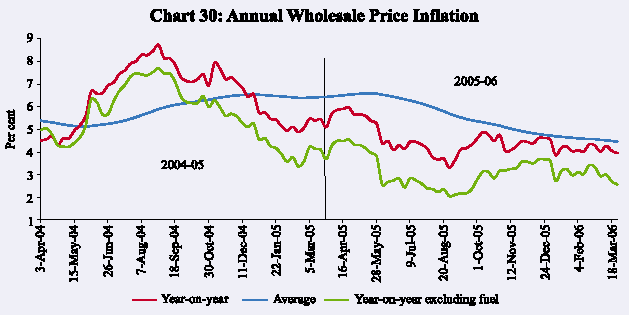
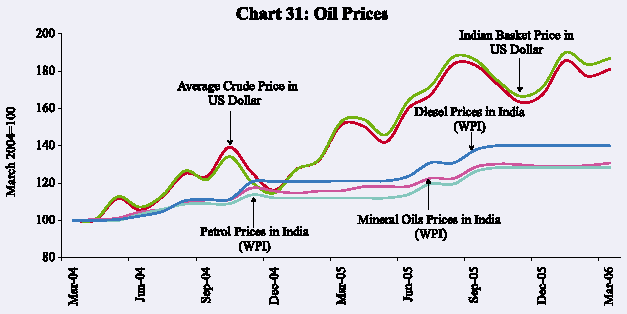
Apart from fuel prices, prices of primary food articles posed some upward pressures on inflation during 2005-06 (Chart 32). Wheat prices firmed up during the second half of 2005-06 on reports of fall in stocks. Prices of pulses, eggs, fish and meat also edged higher during 2005-06. Raw cotton prices after remaining flat during the first half of the year increased marginally during November-December 2005 in tandem with international trends. Oilseeds prices have moderated since November 2005 on account of improved crop prospects. The prices had hardened somewhat during the first half of 2005-06, reflecting last year’s shortfall in domestic kharif production and worries about a poor ensuing crop due to the unsatisfactory progress of the South-West monsoon. On the
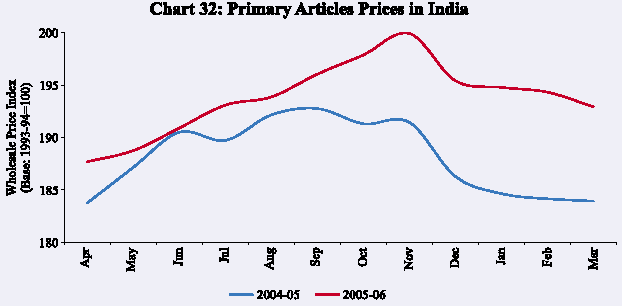
whole, primary articles inflation increased from 1.3 per cent at end-March 2005 to 5.3 per cent at end-March 2006.
Manufactured products inflation remained modest, falling from 4.6 per cent at end-March 2005 to 1.5 per cent at end-March 2006 reflecting stable inflation expectations, productivity gains as well as increased competition. Strong corporate profitability also provided firms the flexibility to absorb higher input prices into their profit margins. Upward pressures from sugar and other food products, cement and non-ferrous metals were offset by easing of prices of manmade fibres, edible oils, oil cakes and iron and steel. Domestic sugar prices remained firm during the year in line with international trends, notwithstanding higher sugarcane output in the country. Domestic metal prices during 2005-06 moved in tandem with trends in international prices. Iron and steel prices in India declined by 7.5 per cent during 2005-06 as against a sharp increase of 21.3 per cent during the previous year. In contrast, non-ferrous metal prices rose sharply. Prices of copper and zinc increased by 40.8 per cent and 39.6 per cent, respectively, during 2005-06 (Chart 33).
In brief, domestic WPI inflation during 2005-06 was dominated by a few items, especially mineral oil prices, which alone contributed almost 41 per cent of the headline inflation. Accordingly, the contribution of the fuel group to y-o-y overall WPI inflation as at end-March 2006 was 49.1 per cent (higher than that of 42.7 per cent a year ago). Manufactured products contribution fell to 22.1 per cent (52.0 per cent), largely on account of a decline in iron and steel prices. On the other hand, primary articles’ contribution to the overall inflation increased to 28.5 per cent (5.5 per cent) mainly due to higher prices of wheat, pulses, vegetables and eggs, meat and fish (Chart 34).
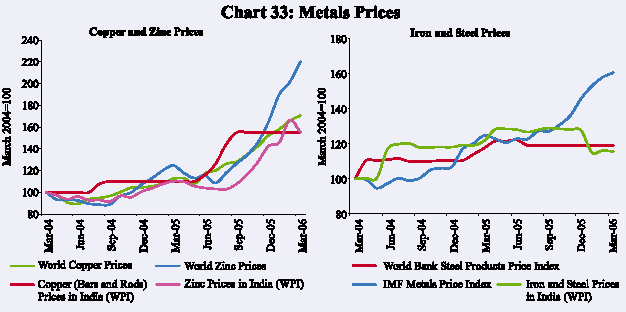
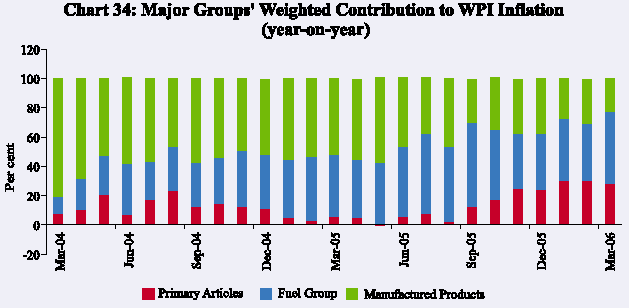
Consumer Price Inflation
Consumer price inflation for industrial workers (CPI-IW) was 5.0 per cent during February 2006 as compared with 4.2 per cent during March 2005 (Table 34). Disaggregated information on CPI-IW available up to December 2005 shows that food prices firmed up from the March 2005 level. Services inflation – proxied by the miscellaneous group in the CPI-IW – edged up mainly reflecting increase in the prices of medical care and ‘education, recreation and amusement’. On the other hand, increase in the housing index – which includes rent paid for rented, self-owned and rent free houses – in the CPI-IW basket decelerated from its March 2005 level (Table 35).
Asset Prices
Equity and gold prices recorded sharp increases during 2005-06. Buoyancy in equity markets continued on the back of better prospects for economic activity, strong
| Table 34: Consumer Price Inflation (CPI) in India (year-on-year) |
||||||||
| (Per cent) |
||||||||
| Inflation Measure |
March |
March |
March |
June |
September |
December |
January |
February |
| 2003 |
2004 |
2005 |
2005 |
2005 |
2005 |
2006 |
2006 |
|
| 1 |
2 |
3 |
4 |
5 |
6 |
7 |
8 |
9 |
| CPI-IW |
4.1 |
3.5 |
4.2 |
3.3 |
3.6 |
5.6 |
4.4 |
5.0 |
| CPI- UNME |
3.8 |
3.4 |
4.0 |
3.9 |
4.8 |
5.7 |
5.0 |
4.8 |
| CPI-AL |
4.9 |
2.5 |
2.4 |
2.7 |
3.2 |
4.7 |
4.7 |
5.0 |
| CPI-RL |
4.8 |
2.5 |
2.4 |
2.7 |
3.2 |
4.9 |
4.7 |
4.7 |
| Memo: |
||||||||
| WPI Inflation |
6.5 |
4.6 |
5.1 |
4.3 |
4.3 |
4.6 |
4.0 |
4.3 |
| IW : Industrial Workers. AL : Agricultural Labourers. RL : Rural Labourers. |
||||||||
| Table 35: Consumer Price Inflation for Industrial Workers (year-on-year) |
|||||||||
| (Per cent) |
|||||||||
| March 2005 |
December 2004 |
December 2005 |
|||||||
| Group/Item |
Weight |
Inflation |
WC |
Inflation |
WC |
Inflation |
WC |
||
| 1 |
2 |
3 |
4 |
5 |
6 |
7 |
8 |
||
| General Index |
100.0 |
4.2 |
100.0 |
3.8 |
100.0 |
5.6 |
100.0 |
||
| 1. |
Food Group |
57.0 |
1.6 |
21.7 |
1.8 |
27.0 |
6.7 |
66.8 |
|
| i. |
Cereals and Products |
20.5 |
0.7 |
2.9 |
0.0 |
0.0 |
4.4 |
14.1 |
|
| ii. |
Pulses and Products |
3.6 |
-2.0 |
-1.9 |
2.7 |
2.8 |
12.8 |
9.0 |
|
| iii. |
Oils and Fats |
5.0 |
-7.1 |
-6.9 |
-0.8 |
-0.8 |
-5.8 |
-4.0 |
|
| iv. |
Meat, Fish and Eggs |
4.3 |
5.0 |
6.3 |
8.1 |
10.8 |
5.0 |
4.7 |
|
| v. |
Milk and Products |
6.5 |
1.7 |
2.5 |
2.9 |
4.4 |
2.2 |
2.2 |
|
| vi. |
Condiments and Spices |
3.2 |
-9.0 |
-7.6 |
-4.1 |
-3.8 |
12.5 |
7.3 |
|
| vii. |
Vegetables and Fruits |
5.7 |
6.5 |
8.2 |
-1.4 |
-2.1 |
22.9 |
22.4 |
|
| viii. |
Other Foods |
8.3 |
7.8 |
17.7 |
6.9 |
17.0 |
5.8 |
10.0 |
|
| 2. |
Pan, Supari, Tobacco and Intoxicants |
3.2 |
2.1 |
2.1 |
3.2 |
3.5 |
1.5 |
1.1 |
|
| 3. |
Fuel and Light |
6.3 |
4.9 |
8.7 |
9.3 |
17.5 |
-5.6 |
-7.6 |
|
| 4. |
Housing |
8.7 |
20.4 |
50.0 |
11.7 |
31.0 |
11.7 |
22.7 |
|
| 5. |
Clothing, Bedding and Footwear |
8.5 |
2.3 |
3.3 |
2.4 |
3.6 |
2.0 |
2.1 |
|
| 6. |
Miscellaneous Group (Services) |
16.4 |
3.9 |
15.6 |
3.3 |
14.6 |
4.9 |
14.7 |
|
| i. |
Medical Care |
2.6 |
4.4 |
3.2 |
3.9 |
3.1 |
6.0 |
3.3 |
|
| ii. |
Education, Recreation and Amusement |
3.1 |
5.1 |
3.4 |
3.6 |
2.6 |
7.1 |
3.6 |
|
| iii. |
Transport and Communication |
2.7 |
6.8 |
5.0 |
4.4 |
3.6 |
6.3 |
3.6 |
|
| iv. |
Personal Care and Effects |
3.3 |
3.2 |
2.5 |
4.1 |
3.5 |
2.5 |
1.5 |
|
| v. |
Others |
4.7 |
1.7 |
1.8 |
1.2 |
1.5 |
3.7 |
2.9 |
|
| WC : Weighted Contribution. |
|||||||||
corporate performance and liquidity support by FIIs and mutual funds (Chart 35). Domestic gold prices remained firm in line with international trends. International gold prices have risen sharply since mid-2005, crossing US $ 600 per ounce in April 2006. Gilt prices fell marginally during the year, with intra-year movements influenced by trends in domestic inflation and liquidity conditions.
